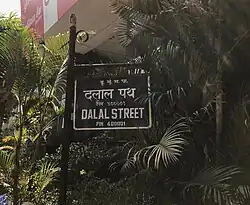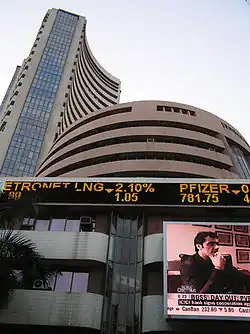Dalal Street
 Dalal Street Sign | |
| Other | |
|---|---|
| Website | www |
Dalal Street (Marathi: dalāl gallī), (Hindi: dalāl path) [1] is the metonym for the financial markets of India, the Indian financial services industry of the country as a whole, or the actual financial district itself.[2] It is located in the Financial District of Fort in Mumbai and is the address of the Bombay Stock Exchange and several other major financial institutions of the world. The Marathi word dalāl means "a broker", "a go-between".[3]
18°55′46.08″N 72°49′59.12″E / 18.9294667°N 72.8330889°E

In 2008, there was a proposal to rename the street after Nagarmal Saraf, a broker who worked at the BSE for 25 years.[4]
History
In the 1850s, local brokers traded informally under banyan trees near Horniman Circle in Mumbai. In 1875, they formed the Native Share and Stock Brokers’ Association, which later became the Bombay Stock Exchange (BSE), establishing Dalal Street as a centre for financial activity.[5]
In 1957, the BSE became the first Indian stock exchange to receive permanent recognition from the Government of India under the Securities Contracts (Regulation) Act, 1956.[5]
In the late 1970s, the BSE initiated the construction of a new 29-storey building. Completed in 1980 and designed by architect Chandrakant Patel, the building was named Phiroze Jeejeebhoy Towers after a former BSE chairman. It remains the BSE’s headquarters.[6]
Significance
Dalal Street is widely recognized as a central hub of India’s financial markets. It houses the headquarters of the Bombay Stock Exchange (BSE), where the SENSEX - India’s first stock market index - was introduced in 1986.[7]
The Securities and Exchange Board of India (SEBI), established in 1988 and granted statutory powers in 1992, also operates from its main office in Mumbai.[8][9] Numerous financial institutions and brokerage firms have established offices in the vicinity of Dalal Street, aligning with its status as a central location for Indian capital markets.
Notable landmarks
- Phiroze Jeejeebhoy Towers – This 29-storey skyscraper, completed in 1980, houses the BSE headquarters.[10]
- Electronic Trading Floors – In 1995, India transitioned from an open outcry system to electronic trading. Both the BSE and other exchanges adopted screen-based systems, many operating from the Dalal Street area.[11]
In the media
The Mumbai based video game Mumbai Gullies is expected to feature the Dalal Street in the fictional map.[12][13]
See also
- Bombay Stock Exchange
- Phiroze Jeejeebhoy Towers
- Phiroze Jamshedji Jeejeebhoy
- Fort (Mumbai)
- Economy of India
- Economy of Mumbai
References
- ^ James Chen. "What Is Dalal Street?". Dotdash Meredith.
- ^ James Chen. "What Is Dalal Street?". Dotdash Meredith.
- ^ McGregor, R. S. (1993). Oxford Hindi-English dictionary. Oxford: Oxford University Press. ISBN 978-0-19-864317-3.
- ^ Suryawanshi, Sudhir (3 March 2008). "Brand new threat to Dalal street". Mumbai Mirror. Archived from the original on 14 December 2023. Retrieved 14 December 2023.
- ^ a b "History and Milestones". Bombay Stock Exchange. Retrieved 18 July 2025.
- ^ "SEBI Order: BSE Corporatisation and Demutualisation Scheme, 2005". Securities and Exchange Board of India. Retrieved 18 July 2025.
- ^ "BSE Milestones". BSE India. Retrieved 18 July 2025.
- ^ "History of SEBI". SEBI. Retrieved 18 July 2025.
- ^ "SEBI Contact Us". SEBI. Retrieved 18 July 2025.
- ^ "BSE Milestones". BSE India. Retrieved 18 July 2025.
- ^ "BSE Milestones". BSE India. Retrieved 18 July 2025.
- ^ "What is Mumbai Gullies?". GameEon. 27 November 2020. Archived from the original on 5 April 2023. Retrieved 18 September 2021.
- ^ Ray, Bodhisatwa (19 January 2021). "Mumbai Gullies, a GTA styled game from an Indian developer, set to launch soon". TechRadar. Retrieved 18 September 2021.
External links
- Bombay Stock Exchange — official web site
- National Stock Exchange official web site
- DalalStreets.com - official web site